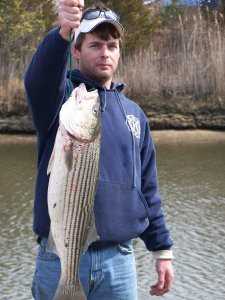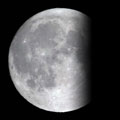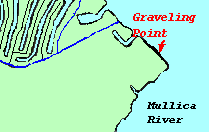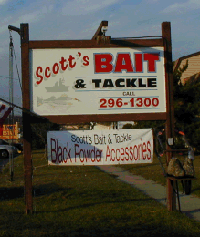| Get to the Point Graveling Point, that is, to catch the season's first striped bass. |
|
By Mark Marquez II |
|
 Mike Barnow checks in 2007's first keeper striper from Graveling Point, a 29-inch 8.9-pounder, at Scott's Bait and Tackle on March 14, winning the shop's annual award of a $100 gift certificate for the first. |
Finally. After a long winter, striped bass season opens March 1 in New Jersey’s bays and rivers. There’s only one thing to do. Get to the point. Graveling Point, that is. Every year some of the season’s first striped bass are reeled in at this quarter-mile stretch of beach, located at the convergence of Great Bay and the Mullica River, near the end of Radio Road in Mystic Island. Why here? |
The higher temperatures on outgoing tides attract the cold, lethargic stripers. Plus, at this time of year, many anglers are yet to put boats in the waters. But a few other areas on the bay and river are popular with bank anglers, giving up plenty of the fish early in the season. These include Pebble Beach on the bay at Ohio Drive, the banks of the Mullica around the Garden State Parkway Bridge, and Clarks Landing up the river. |
|
Bloodworms are traditionally the bait of choice for the early season stripers. Baits like bloods and grass shrimp seem easiest for the stripers to digest, when the metabolism of the fish is slowed down from the cold. Berkley artificial bloodworms can also draw bites, but not as much as the real deal. Still, the artificial bloods are a smart addition to the tackle box as a standby, when real worms run out. |
|
Clams will also work and sometimes attract bites when the fishing is “on,” Scott said. That was certainly the case when the bite was peaking last year, he said. Later in the season, when waters warm and the fish become more aggressive, herring and eels become popular baits. But that usually happens around May, when the migration of herring up the rivers from the ocean is long under way. Anglers will flock to Graveling Point on March 1, but that doesn’t mean the fish will bite. Water temperature is key, and 43-degree waters is the earliest Scott ever saw the first catches made. Waters 45 degrees will probably jump start the fish to bite in any serious way. When this article was posted in late February, the bay was 38 degrees, and the ocean was 44. “You never know,” Scott said. He expects the first real action to begin by the second week of March. Scott’s Bait and Tackle annually awards a $100 gift certificate to the angler who checks in the season’s first keeper striper from Graveling Point. The shop’s Web site includes a page that lists the first keepers and the early season water conditions going back more than 10 years. Last year the first keeper, a 29-incher, one inch larger than the minimum size, was weighed in at the shop on March 14, according to the site. |
|
During the previous year the first keeper hit the scale on March 5, and three years ago the first arrived March 29, the latest ever at the shop. So the first legal fish were brought in during all different times throughout the month. They all were caught when the water was in the mid 40s. Undersized stripers were often, but not always, reported caught and released in the first days of March. |
 Bloodworms are the bait of choice for stripers at Graveling Point in the early season, when the cold, lethargic fish prefer a meal that's easy to digest. Later, when the waters warm, herring and eels will attract strikes. This trophy blood was 30 inches, the longest ever seen at Scott's! |
Water temperature certainly seemed a factor. For example, when the first keeper was reeled in on March 5 two years ago, the bay was 44 degrees in late February. Compare that with 38 degrees this year. Low tides are no doubt the best time to connect with the fish in the early season. The warmer waters seem the reason. High tides produce the most catches later in the season, for unknown reasons, Scott said, probably something to do with water temperature. High-low rigs--Pompano-style rigs--are most popular for the fishing. Size-1/0 hooks are favored early in the season, and 3/0 hooks become popular later, when anglers toss bigger baits to more aggressive fish, trying to land a large one. Customers of Scott’s who frequent the point usually toss 17-pound line on a 10-foot rod. A larger rod, like commonly used from the shore of the ocean, is unnecessary, because there’s no surf in the bay to clear with a longer pole. These fish will stick around until the season’s first bluefish invade, usually by May 10. By then, striper anglers will fish other areas that start to turn on, like the ocean surf on Long Beach Island. Striper anglers will also start boating more frequently in May, and at this time they’ll target areas including Grassy Channel in Great Bay. But local bank anglers will still hunt down stripers, and the shore along Sheepshead Creek will become a favorite. The anglers there will still have to fight through blues, though. Nearby Little Egg Inlet isn’t such a productive spot for stripers in spring, and autumn is the time when the inlet is the place bail them. Keeper stripers at Graveling Point are mostly 28 inches to 31 inches, and a 34-incher is a big one. Nothing big, but plenty of keepers eventually show up. |
|
|
Different size classes, probably different year classes, seem to come through in waves. One day will give up 24-inch fish, for example, and another will turn up 28-inchers. These are migrating fish coming from the ocean, probably to spawn up the rivers, Scott said. The migrators are silver and black, |
To reach Graveling Point, anglers hike up the beach from the end of Radio Road. A creek has to be crossed, and the water is deep during mid to high tides, even deeper than a person’s head at high waters. So be careful about the tides, and waders are a good idea. Low tides are completely manageable, require no waders to ford the creek, and are the best to fish earlier in the season anyway. When crossing the creek, stick to the sandbar at its mouth, and avoid venturing too far either into the bay or toward the creek, or you might end up swimming. Be careful not to get stranded on the point side of the creek when the tide rises. Scott was asked why the area is named Graveling Point, and he was unsure. Maybe the name came from the fine, silty sand on the bottom that could resemble gravel. The bottom is a gradual drop-off--the sort of shallow flats that warm the waters and that stripers are known to haunt toward spring--with no real holes or structure. A big northwest storm one year pushed the tides 3 feet lower than normal, and Scott got a good view of the bottom. Scott’s Bait and Tackle, located up the street from Graveling Point at 945 Radio Road, carries all tackle, bait, gear, rods and reels used for the fishing, and all local fishing from pickerel in the ponds to tuna offshore. Scott Albertson, the owner, is a wealth of information about fishing the local area. He’s a native and grew up with the sport. I’ve spoken with anglers who said Scott might not give away all the secrets at a given time. But they’ve also said he’s generous, considerably more helpful than usual to get anglers on the bite. That also seemed the case when I spoke with him for fishing reports over the years. Another feature of the store is Penn Parts, including PennParts.com, a one-of-a-kind source of more than 6,000 parts from the popular reel manufacturer. Every Penn part still manufactured is available, and so are lots that are no longer manufactured. Penn Parts might be the biggest provider of the parts around. The store’s Web site also features loads of information, including fishing reports, fishing photos and info pages about the different fishing available in the local area throughout the year, including a great section about Graveling Point fishing. So don’t mess around when stalking early season stripers. Get to the point. Graveling Point! |
|







